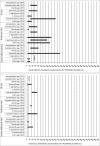Presence of Bacteroidales as a predictor of pathogens in surface waters of the central California coast
- PMID: 20639358
- PMCID: PMC2935056
- DOI: 10.1128/AEM.00635-10
Presence of Bacteroidales as a predictor of pathogens in surface waters of the central California coast
Abstract
The value of Bacteroidales genetic markers and fecal indicator bacteria (FIB) to predict the occurrence of waterborne pathogens was evaluated in ambient waters along the central California coast. Bacteroidales host-specific quantitative PCR (qPCR) was used to quantify fecal bacteria in water and provide insights into contributing host fecal sources. Over 140 surface water samples from 10 major rivers and estuaries within the Monterey Bay region were tested over 14 months with four Bacteroidales-specific assays (universal, human, dog, and cow), three FIB (total coliforms, fecal coliforms, and enterococci), two protozoal pathogens (Cryptosporidium and Giardia spp.), and four bacterial pathogens (Campylobacter spp., Escherichia coli O157:H7, Salmonella spp., and Vibrio spp.). Indicator and pathogen distribution was widespread, and detection was not highly seasonal. Vibrio cholerae was detected most frequently, followed by Giardia, Cryptosporidium, Salmonella, and Campylobacter spp. Bayesian conditional probability analysis was used to characterize the Bacteroidales performance assays, and the ratios of concentrations determined using host-specific and universal assays were used to show that fecal contamination from human sources was more common than livestock or dog sources in coastal study sites. Correlations were seen between some, but not all, indicator-pathogen combinations. The ability to predict pathogen occurrence in relation to indicator threshold cutoff levels was evaluated using a weighted measure that showed the universal Bacteroidales genetic marker to have a comparable or higher mean predictive potential than standard FIB. This predictive ability, in addition to the Bacteroidales assays providing information on contributing host fecal sources, supports using Bacteroidales assays in water quality monitoring programs.
Figures




References
-
- APHA. 2001. Standard methods for the examination of water and wastewater, 21st ed. American Public Health Association, Washington, DC.
-
- Bae, S., and S. Wuertz. 2009. Rapid decay of host-specific fecal Bacteroidales cells in seawater as measured by quantitative PCR with propidium monoazide. Water Res. 43:4850-4859. - PubMed
-
- Bang, D. D., F. Scheutz, P. Ahrens, K. Pedersen, J. Blom, and M. Madsen. 2001. Prevalence of cytolethal distending toxin (cdt) genes and CDT production in Campylobacter spp. isolated from Danish broilers. J. Med. Microbiol. 50:1087-1094. - PubMed
-
- Beaches Environmental Assessment and Coastal Health Act. 2000. Beaches Environmental Assessment and Coastal Health Act. Stat. 870-877, Public Law 106-284. 106th U.S. Congress, Washington, DC.
Publication types
MeSH terms
LinkOut - more resources
Full Text Sources
Miscellaneous

